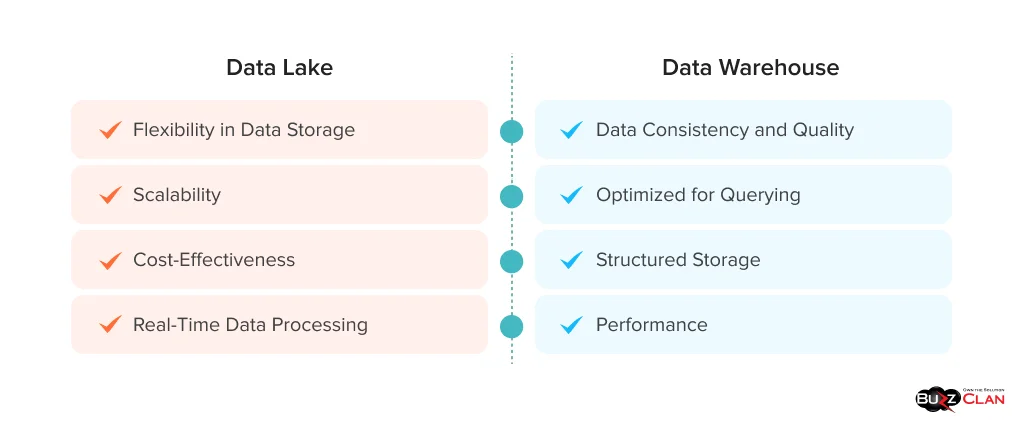Data Lake vs Data Warehouse: The Complete Guide for Machine Learning Projects
Ananya Arora
Feb 28, 2025
Data lakes and warehouses are repositories that store structured and unstructured data, which can be information in photos, text, videos, audio, and other formats. From the beginning, data has played an integral role in determining success. Data helps organizations analyze the current market state and make informed and precise decisions based on past events.
Data lakes and warehouses are crafted to store, process, and analyze raw data, making sense of the information, including user activity, customer preferences, demand-supply metrics, etc. However, if it comes to machine learning, you must choose carefully. Both of them have their benefits and drawbacks when discussing machine learning. Let’s understand data lake and warehouse and which is better for machine learning.
What is a Data Lake?
Let’s learn what a data lake is from an example. Suppose you have a toy box; in that toy box, you have various toys (dolls, legos, clay). Now, understand that this toy box is what we call a data lake, and the types of toys are types of data, i.e., structured (doll), unstructured (clay), and semi-structured (lego bricks). Data lakes store extensive amounts of raw and unstructured data, which gives a substantial advantage when working with machine learning. Data lakes offer flexibility, scalability, and integration with advanced tools at a cost-effective level. Moreover, it highly supports big data analytics and real-time and batch processing.
Machine learning engineers and data scientists can leverage the capabilities of data lakes by experimenting with and exploring the raw data. This further enhances feature engineering and helps build custom data pipelines. Additionally, the highly scalable nature of data lakes boosts the ML workloads and big data storage.
What is a Data Warehouse?
A data warehouse is like a well-maintained fancy bookshelf that neatly and accessibly stores books (structured and historical data). It stores extensive databases, logs, files, and other structured data so that data scientists can extract and analyze it. ETL processes are used to clean and neatly store the data effectively.
Moreover, due to their high efficiency and boosted performance, data warehouses prepare data for analysis and further utilization in machine learning models used for sales forecasting and customer segmentation. Business intelligence tools are also seen to effectively advance integration with machine learning predictive models, offering accuracy in the data as structured data gives more accurate, fast, and result-oriented results than raw and unstructured data.
Key Benefits of Data Lake & Warehouse for Machine Learning

There are several benefits of using data lake and warehouse, enhancing machine learning and other projects; some of these are as follows:
Data Lake
Data lakes deal with unstructured data, which has been very helpful for machine learning models to experiment with and create valuable insights. Here are some key benefits of data lakes that help in machine learning projects.
- Flexibility in Data Storage: Systems operate with all three types of data structures. This solution easily stores raw data, such as log files or images from IoT devices.
- Scalability: The system can process data volumes of any size for machine learning model development. Cloud-based storage grows naturally to handle more enormous datasets without manual effort.
- Cost-Effectiveness: Keeping raw data in this storage type costs less than keeping filtered or organized data in other systems.
- Real-Time Data Processing: The system receives and analyzes streaming data so teams can perform real-time analyses for applications such as detecting fraud and dynamically adjusting prices.
Data Warehouse
Data warehouses provide structured data, improved data quality, and analytics that support aggregated data and reduce ML engineers’ preprocessing efforts. Here are some of their advantages for machine learning projects.
- Data Consistency and Quality: Producing properly formatted validated data makes developing stable machine learning models feasible.
- Optimized for Querying: The system allows users to run fast SQL searches, which can be used to summarize and paste data for developing features.
- Structured Storage: The system stores data in table structures to help users more effectively obtain the information they need for their machine-learning applications.
- Performance: The system runs queries at high speed for analytic tasks to support ML model assessments and development.
- Support for Aggregated Data: The system gives engineers pre-wrapped data collections that simplify data preparation work.
- Predictable Performance: The solution provides consistent performance results across different training datasets designed for batch processing.
Data Lake and Machine Learning: How They Work Together
Data lake and machine learning go hand in hand. Machine learning gets exclusive benefits from the data lake and its components and capabilities for doing deep analysis and predictive modeling.
Real-Time Data Collection for ML Pipelines
Today’s modern data lakes have built-in capabilities to extract real-time information from assets, including IoT devices, social media feeds, and transactional systems. Knowing that ML models perform better using fresh data represents a critical capability of modern data lakes. Detecting and countering fraudulent events in real-time systems works because real-time data enables models to act on identifying fraud occurrences.
Data Cleaning and Transformation for Training
Data preprocessing becomes crucial before training Machine Learning models within data lakes. The data preparation consists of washing raw information to reject mistakes while fixing data gaps and creating an appropriate structure for research purposes. AI-powered data cleaning technology automatizes anomaly identification and automatic correction, creating high-quality training datasets and higher prediction precision results from efficient data preparation techniques in ML modeling systems.
Deep Learning and Big Data Processing
Broadly diverse datasets represent the perfect operational environment for deep learning models. Data lakes present the storage and processing capabilities that organizations need to handle big data applications, enabling the training of neural networks in complex configurations. Organizations can boost the efficient processing and analysis of extensive datasets through distributed computing frameworks, allowing them to create sophisticated deep learning applications, including image recognition and natural language processing.
Data Warehouse and Machine Learning: How They Work Together
What happens when structured data (well-maintained and tagged data) collaborates with one of the advanced technologies, i.e., machine learning? Many actionable and invaluable insights take place, leading to innovations and growth. Let’s learn in brief how data warehouse and machine learning work together:
Historical Data Analysis for Predictive Models
Predictive modeling. Predictive modeling is a process in which machine learning algorithms take future data, events, trends, and actual statistics and predict what is likely to happen. At what time, when, how much, with whom – everything. This is the power of predictive analytics. With its loads of historically structured data, a data warehouse helps machine learning’s predictive models make exact decisions. For example, a store like Walmart can analyze its past sales and what customers bought the most in a particular season and tell which products will be in demand and the quantity.
Structured Data Optimization for Supervised Learning
In data warehouses, the data is pre-structured, free from preprocessing, and exceptionally suitable for supervised learning. Supervised learning is a technique that is an integral part of machine learning. It utilizes the cataloged data to train ML models and algorithms to predict the future. This supervised learning helps in various industries and fields. For example, this technology can help predict customer purchasing behavior in retail by analyzing structured sales data.
Using Data Warehouses in ML for Reporting and Insights
One of the optimal features of a data warehouse is querying and reporting. Big organizations like Apple, Google, and Microsoft boost their reviews and reporting by incorporating machine learning insights and increasing the potential of their business intelligence tools. Are you thinking about how this would help companies? It helps them enhance the executive review and get a clear and broad image of the future. This helps to see what the future may look like. For example, a company named ‘X’ can see its sales for the entire year if it has data from the last year and the sales data for the past few months. Then, they can learn how sales will perform and present this data in their presentations.
Data Lake vs. Data Warehouse: Key Differences
Data lake and warehouse have their peaks and valleys, i.e., benefits and limitations. But which one is more suitable for machine learning? Do you want to know? Let’s check it out.
| Key Differences | Data Lake | Data Warehouse |
|---|---|---|
| Data Types | Unstructured, semi-structured, and structured data. | Structured data. |
| Flexibility (schema approach) | It provides more flexibility with the schema-on-read approach, helping ML models as in this methodology, raw data is stored, and then the schema is applied when read. | It provides less flexibility but more consistency with a schema-on-write approach. Requiring data to be cleaned and structured before storage. |
| Cost-Effectiveness | Low Costs. As raw data can be easily stored and processed later on. | Higher costs. As raw data needs to be processed and structured before storage. |
| Data Processing | It follows the ELT (Extract, Load, Transform) processes. The data is transformed according to the requirements, which is highly suitable for ML exploratory data analysis. | It follows ETL (Extract, Transform, Load) processes, which require data transformation before loading occurs. Therefore, it is less suitable for ML experimentation. |
| Performance | It may exhibit slower query performance due to the lack of predefined schemas and indexing, necessitating additional processing during data retrieval. | Because of structured data, the query performance is fast, making it efficient for generating reports and dashboards. |
| Use Cases for ML | It assists in training complex ML models with its ability to store and process diverse raw datasets. | Suitable for statistical analysis, reporting ML applications, and historical data analysis. |
Data lakes and warehouses each have individual benefits for machine learning. However, the advantages of a data lake surpass those of a warehouse when compared for suiting with machine learning. Moreover, companies and organizations utilize data lakes and warehouses to optimize data engineering, performance, and operations to the maximum extent possible.
Data Lake vs. Data Warehouse vs. Data Mart for Your ML Projects
First, the data comes into the data lake and stays there. Then, it goes into the data warehouse and is compiled, organized, set in catalogs, and labeled. After this, data mart comes into play. Data marts are unique subsets of data warehouses that include specific data related to a department’s needs and requirements or a business function. These subsets are made with the help of ETL processes and can be later used for business operations and analysis. Here is a detailed comparison of data lakes, warehouses, and marts.
| Components | Data Lake | Data Warehouse | Data Mart |
|---|---|---|---|
| Definition | Central repository for raw, unprocessed data. | Structured storage for processed data. | A subset of data warehouses focused on specific needs. |
| Data Type | Unstructured, semi-structured, and structured data. | Primarily structured data. | Summarized and filtered data for particular functions. |
| Purpose | Supports big data analytics and machine learning. | Optimized for complex queries and reporting. | Quick analysis for specific departments or functions. |
| Scalability | Highly scalable, accommodating large volumes. | Scales horizontally but can be costly. | Limited by the underlying warehouse's capabilities. |
| Cost Efficiency | Cost-effective for storing vast amounts of data. | More expensive due to processing and storage needs. | Generally lower costs focused on specific datasets. |
| User Access | Accessible to data scientists and engineers. | Business users can easily access structured insights. | Tailored access for specific business units. |
Challenges in Using Data Lakes and Data Warehouses for Machine Learning
Several challenges that can occur while implementing and using data lakes and warehouses for machine learning operations and projects are as follows:
Challenges with Data Lake
Here are some challenges that occur while using a data lake for machine learning:
- Data Swamps: Data swamps are created when massive amounts of unorganized raw data are collected within a data lake, only being sorted with proper governance. Data lakes are known to store vast piles of raw data. They often create data swamps, which create inconsistencies and inaccuracies, eventually making it hard to maintain data quality. This can further develop issues concerning machine learning models and applications.
- Data Integration: Integrating data can become complex and requires high-tech tools to smooth the deposition of raw data from diverse sources into a data lake.
- Concerns about Querying & Retrieving: Data lake architecture often makes it problematic for ML applications to perform well when probing and fetching vast amounts of data from multiple sources and in numerous formats.
Challenges with Data Warehouse
Here are some challenges that occur while using a data warehouse for machine learning:
- Expensive: Building a warehouse isn’t easy. Building and maintaining a data warehouse requires a high budget and extra effort in a business’s infrastructure and ongoing management.
- Scalability Challenges: Scaling the data warehouse isn’t swift or straightforward due to high data volumes. Engineering pushes, and labor is required to make this happen.
- Data Integration Complexity: In warehouses, data is extracted from multiple sources and then organized and tagged managerially to streamline future utilization. This requires extensive ETL (extract, transform, load) processes, which often take too much time and are prone to errors.
Always hectic to deal with challenges. Isn’t it? However, you can deal with some of these challenges by implementing data as a product (DaaP) approach. In this approach, data sets are made as products. These data sets are made by keeping in mind what the user wants. These products enhance usability, user satisfaction, and quality.
Real-World Examples of Data Lakes and Data Warehouses in Machine Learning
Big companies like Uber, Nestle, and Netflix have used data lakes and warehouses. Let’s look at some real-world examples concerning machine learning:
Data Lake Example: How Netflix Uses Data Lakes for Recommendation Systems
Recommendations from Netflix depend on advanced data lake architecture to personalize content recommendations to users through their recommendation system. Through a centralized data lake that collects extensive user-based information such as viewing histories, search patterns, and interaction behavior. Netflix can perform data analysis to produce individualized recommendation content. The combination of personalization through recommendations followed by improved user satisfaction grows user engagement while becoming the foundation of content consumption on the platform.
Data Warehouse Example: How Financial Institutions Use Data Warehouses for ML Models
Financial organizations use data warehouses to collect and handle structured information from diverse sources, enabling the development and deployment of machine learning frameworks. Combining transactional data, market information, and customer profiles within one data warehouse enables financial institutions to run advanced analytics and predictive modeling capabilities. Machine learning algorithms function within financial applications to uncover suspicious transactions while analyzing credit risks and investment plan optimizers. ML models need accurate and reliable data, which the centralized warehouse structure at data warehouses provides by improving data consistency and quality throughout the system.
Transform Your ML Data Architecture with BuzzClan’s Expertise
Practical machine learning relies on more than just algorithms—it starts with a well-designed data architecture. At BuzzClan, we specialize in creating robust, scalable, and efficient data ecosystems that empower ML initiatives.
With our expertise, your data architecture will be ready to support advanced ML use cases like predictive analytics, natural language processing, and computer vision. Whether starting from scratch or optimizing an existing system, we help you create a foundation that drives results.
Contact us to invest in a modern, ML-ready data architecture to ensure your business stays competitive in tomorrow’s data-driven world.
Conclusion
Data lakes and warehouses are the best ways to manage, process, and store data. Companies can make the most of both by using both. Choose data lakes when you deal with multiple types of unorganized data and want to work with raw data, plus train big ML models. Several providers are Amazon (AWS S3), Google (Google Cloud Storage), and Microsoft (Azure Data Lake Storage). When you want to create features from clean data or run advanced analytics, choose a data warehouse setup. Some examples are Snowflake, Amazon Red Shift, and Google BigQuery.
Choose a single or hybrid of these methodologies according to your organizational and machine learning project’s needs and requirements. Analyze their challenges carefully and opt for an approach that best suits your organization’s data (structured or unstructured). Moreover, to utilize the methodologies and strengthen your data architecture, contact BuzzClan for a smooth and effective data foundation involving data virtualization, data integration, and big data processing transition for advanced AI and ML operations.
FAQs

Get In Touch
Follow Us

Get In Touch
Follow Us
Table of Contents
- What is a Data Lake?
- What is a Data Warehouse?
- Key Benefits of Data Lake & Warehouse for Machine Learning
- Data Lake and Machine Learning: How They Work Together
- Data Warehouse and Machine Learning: How They Work Together
- Data Lake vs. Data Warehouse: Key Differences
- Data Lake vs. Data Warehouse vs. Data Mart for Your ML Projects
- Challenges in Using Data Lakes and Data Warehouses for Machine Learning
- Real-World Examples of Data Lakes and Data Warehouses in Machine Learning
- Transform Your ML Data Architecture with BuzzClan’s Expertise
- Conclusion
- FAQs











